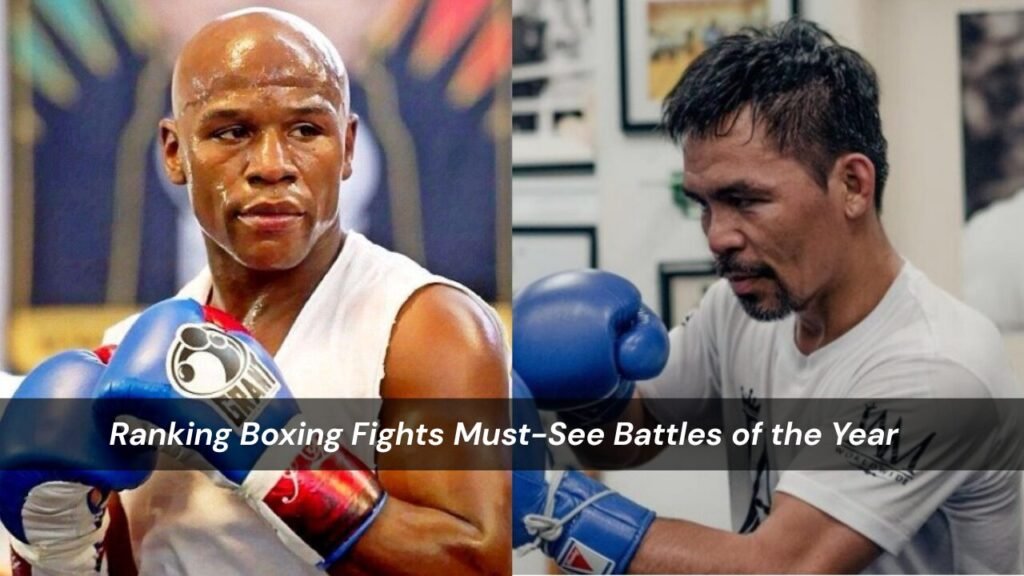Boxing has long been known as “the sweet science,” a sport that blends raw power with refined skill. Across decades, it has given fans moments of glory, heartbreak, and unforgettable drama. The sport is more than a contest of fists; it is a test of strategy, endurance, and courage where legacies are built one round at a time. Fans follow not just fighters but the stories behind them rivalries, national pride, comeback journeys, and the pursuit of greatness.
In this rich landscape, ranking boxing fights serves as a way to celebrate these stories while preserving history. Rankings highlight the best of the best, allowing fans to revisit classics, compare eras, and spark debates about which fights truly defined the sport. Whether it’s the explosive heavyweight rivalries or lightning-fast clashes in lighter divisions, ranking fights keeps boxing alive in conversations long after the final bell has sounded.
The Importance of Ranking Boxing Fights
Ranking fights matters because it ensures that special moments are not lost to time. Every great bout is more than a winner and loser; it’s a chapter in boxing’s story. Rankings give context, showing why certain fights resonated with fans and stood out in history. For newer fans, rankings act as a guidebook, pointing them toward matches that showcase boxing’s best qualities. For long-time followers, rankings are reminders of nights when the sport delivered pure magic.
This process also fuels healthy debate, as fans rarely agree on which fights deserve the top spots. Some value technical mastery, while others prefer action-packed slugfests. By ranking fights, the sport creates a living archive that combines both perspectives, ensuring boxing’s diverse appeal remains intact.
Factors That Define a Great Boxing Fight
Not every fight earns a place in history. To be ranked among the best, a bout must check several boxes. Competitiveness is key; one-sided fights rarely make the list no matter how impressive the winner was. Stakes matter too; a fight for a world title or a legacy-defining matchup carries more weight than an exhibition. Beyond this, the drama inside the ring, the shifts in momentum, the resilience of fighters, and the crowd’s energy plays a decisive role.
When boxing fights, experts also consider the cultural or historical backdrop. A fight might be remembered not just for its punches but for what it symbolized at the time. This makes rankings multidimensional, blending athletic performance with social and cultural significance.
Skill Versus Drama
Some fans argue that skill should dominate rankings, praising defensive brilliance and technical precision. Others believe that chaos, knockdowns, and relentless exchanges create fights that stick in memory. The truth lies in the middle. A masterful defensive showcase can impress analysts, but fights that deliver blood, sweat, and tension often live longer in fan discussions. The best-ranked bouts typically offer both—a balance of artistry and drama that satisfies every type of boxing fan.
Historical Context in Fight Rankings
History gives rankings depth. Without context, a fight is just statistics on paper. Ali versus Frazier wasn’t simply a heavyweight clash it was a cultural moment that divided and united fans worldwide. Hagler versus Hearns wasn’t just three rounds; it was a fiery explosion that redefined aggression in boxing. Mayweather versus Pacquiao was the culmination of years of anticipation, symbolizing an era where boxing reigned globally.
By comparing legendary bouts from different eras, boxing creates a bridge across generations. It gives today’s fans the chance to understand how older fighters battled through unique challenges, styles, and rivalries, while also appreciating the intensity and drama that shaped those eras. This connection helps audiences see how the sport has evolved—how techniques have changed, how conditioning has advanced, and how storytelling within boxing has grown richer. At the same time, it reminds us that while the athletes and settings may change, the heart of the sport, the courage, determination, and unforgettable moments inside the ring remains timeless.
Modern Boxing and the Evolution of Rankings
Today’s boxing world looks very different from the past. With social media, instant streaming, and worldwide access, fights are viewed and judged by millions in real time. Rankings are no longer the domain of a few journalists; fans from every corner of the globe contribute their voices to the debate. This democratization makes rankings more inclusive and dynamic, reflecting the diverse appeal of the sport.
The Role of Media and Analytics
Technology has also introduced data-driven analysis into rankings. Statistics like punch accuracy, defensive success rates, and stamina give fans measurable insights into fights. However, data alone cannot capture the electricity of an unexpected knockout or the resilience of a fighter who refuses to quit. Rankings today therefore mix analytics with emotion, producing a fuller picture of why certain fights stand above others.
Ranking Boxing Fight in Different Divisions
Every division tells its own story, producing unique classics that deserve recognition. Comparing fights across weight classes can be difficult, but it also highlights the variety that makes boxing special. Rankings ensure that both heavyweight blockbusters and featherweight thrillers share the same stage in history.
Heavyweight Drama
The heavyweight division remains boxing’s crown jewel. Its allure lies in raw power—the knowledge that one punch can end a fight in an instant. From Ali’s duels with Frazier and Foreman to Tyson Fury’s trilogy with Deontay Wilder, heavyweight fights often dominate rankings because of their scale, drama, and legacy impact. Fans often remember these fights as spectacles, moments that transcended sports and entered cultural memory.
Lighter Division Masterpieces
But excitement is not exclusive to heavyweights. Lighter divisions such as lightweight, featherweight, and bantamweight have produced breathtaking battles full of speed, precision, and relentless exchanges. Fighters in these divisions rely on agility, stamina, and technique, often creating fights with nonstop action. When ranked alongside heavyweight bouts, these fights demonstrate that greatness in boxing is not measured by size but by skill, heart, and intensity.
The Emotional Impact of Great Fights
The most highly ranked fights often share one quality: emotion. Whether it’s an underdog upsetting the favorite, a last-round comeback, or a rivalry fueled by pride, emotional resonance elevates fights beyond statistics. Fans remember where they were when these moments happened, replaying the memories for years. Rankings capture that emotional power, reminding us why boxing continues to be one of the most captivating sports in the world.
The Future of Fight Rankings
The future of boxing rankings looks brighter than ever. With global access, rising stars from new regions, and advanced analytics, future rankings will reflect an even broader picture of the sport. Fans will continue to debate their choices, and analysts will continue to measure greatness by combining skill, drama, and context. What will remain constant is the purpose: to celebrate the moments that defined boxing and ensure they live forever in the hearts of fans.
Conclusion
In the end, ranking boxing fights is a way of honoring the soul of the sport. It captures the artistry, the sweat, and the emotion that make boxing timeless. Rankings are more than numbers on a list; they are stories of courage, determination, and unforgettable nights. They help preserve the past while fueling debates about the present and future, keeping fans connected across generations.
Boxing is unpredictable. A single punch can change the course of history, and a fighter’s willpower can inspire millions. Rankings ensure that these moments are never forgotten. They allow fans to relive the greatest nights, compare legends across eras, and witness the sport’s evolution. As new stars rise and fresh classics unfold, the tradition of ranking fights will continue to grow, giving boxing fans endless stories to celebrate.
FAQs
What does it mean to rank boxing fights?
Ranking fights means organizing and evaluating bouts based on criteria such as competitiveness, skill level, entertainment, and historical importance. It helps fans identify the most impactful fights in boxing history.
How are fights usually ranked?
Fights are ranked by looking at technical brilliance, the stakes involved, and the level of excitement generated. Analysts also consider crowd reactions and the cultural impact of the event.
Do only championship fights get ranked?
Not at all. While title fights often gain attention, non-title clashes can be just as memorable. If a bout delivers extraordinary drama, skill, or historical weight, it can earn a top spot in rankings.
Why do fans debate rankings so much?
Boxing is deeply personal to fans. They connect with fighters’ stories, styles, and victories, which makes them passionate about defending their favorite moments when rankings are discussed.
Can modern fights be compared to older classics?
Yes, though it’s challenging. Different eras bring different styles, rules, and competition levels. Rankings provide a framework to compare fights while respecting the uniqueness of each period.
Do statistics play a role in rankings?
Statistics are valuable for measuring accuracy, defense, and efficiency, but they don’t tell the whole story. The drama, atmosphere, and emotional thrill of a fight also weigh heavily in its ranking.
Will rankings ever be completely objective?
No, boxing combines both science and art. While data can guide objectivity, emotions and perspectives will always influence how fights are ranked, keeping debates alive and interesting.




